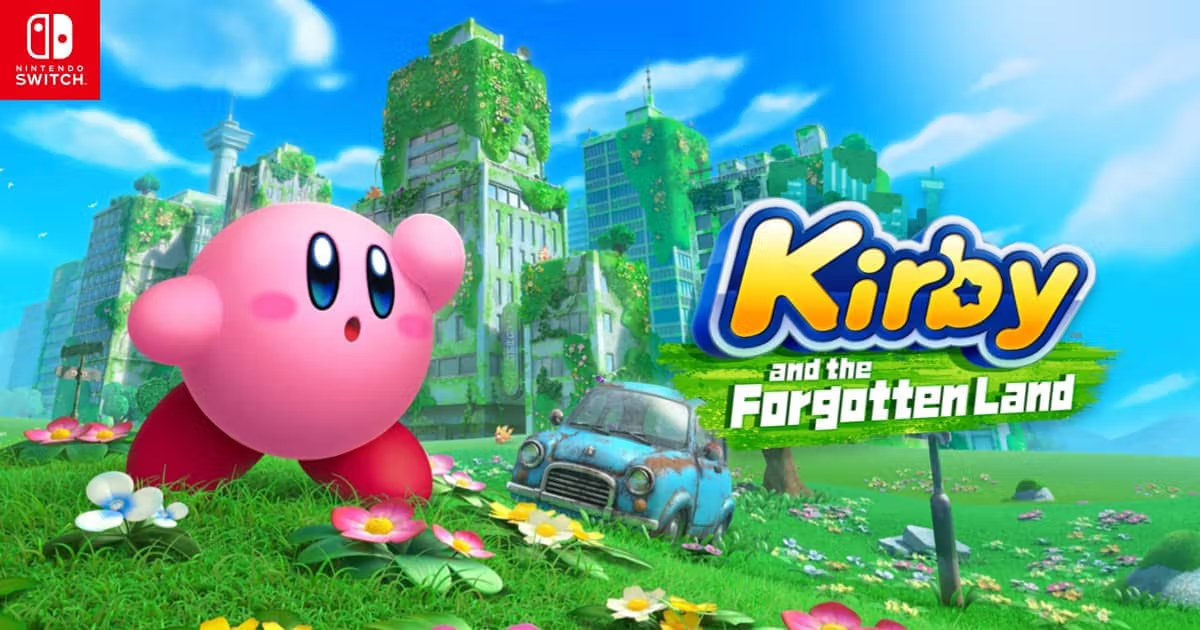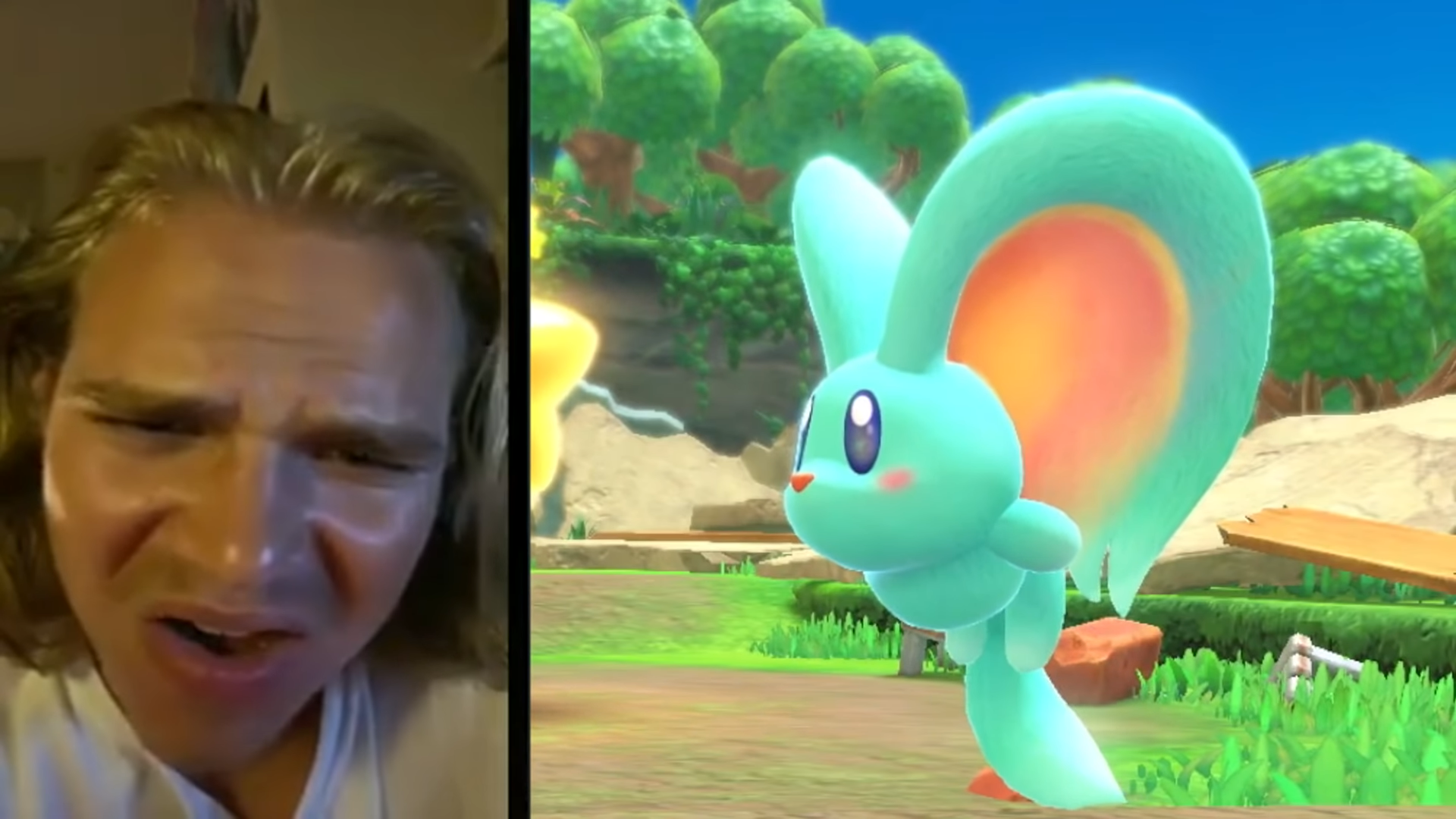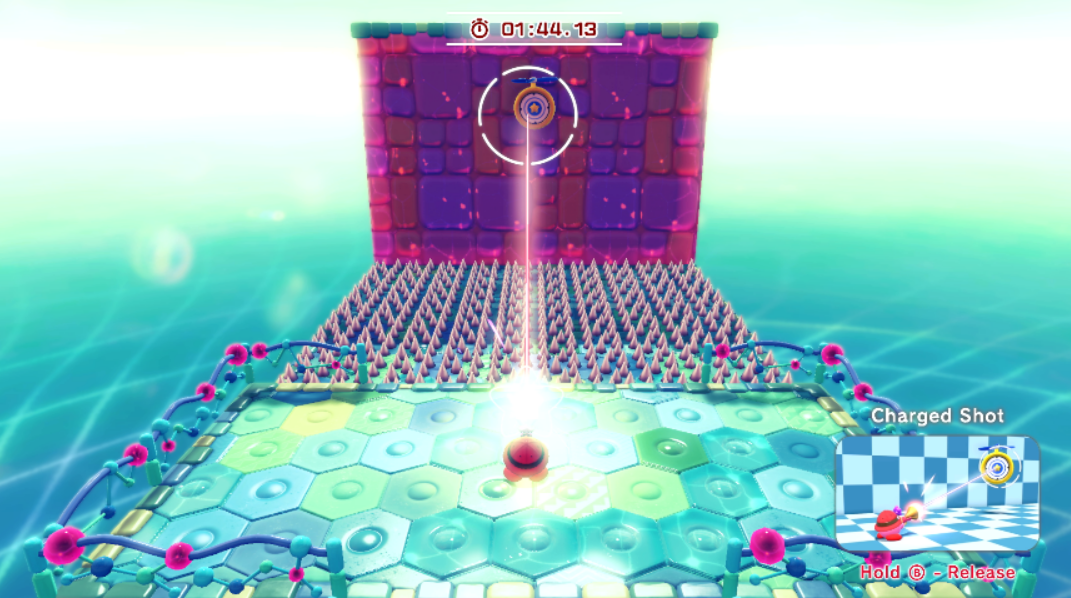Kirby and the Forgotten Land Review
by Jack Burke, Form VI
12 min. read — April 29, 2022

On September 23rd, 2021, Nintendo revealed that Kirby, the beloved pink puffball, would finally be venturing into the third dimension. This announcement was exciting for many fans of the series, although not necessarily unexpected considering the fact that a 3D Kirby game was heavily rumored over the course of the previous year, and promotional materials for the game had leaked on Nintendo’s website a day before. For my less game-savvy readers, while Kirby had been portrayed in a graphically 3D environment before, his movement had been restricted to the second dimension, except in spinoffs, since his first outing in 1992. Actually, the word “dimension” is more relevant than ever, Kirby finds himself sucked into a wormhole leading to another dimension where the entire game takes place. I’m sure the developers had fun using that play on words as the core concept for the story.
Speaking of the story, I’ll be avoiding spoilers as much as possible, so make sure you pick up the game and play it for yourself if you’d like to learn more. Those unfamiliar with the Kirby series may be surprised to learn that for a game about a cute pink ball in an equally cute world; Kirby stories can get quite dark as the game progresses. Not a single game goes by without a major character being possessed at least once, and the stakes are often apocalyptic in nature. Major characters (usually villains) can end up with their souls shattered, consumed, or deleted irreparably by the end of the game, and Kirby’s beloved Planet Popstar has nearly been destroyed more than once. I find this at least a bit ironic when you consider the fact that the developers stated in an interview that they can’t stand to see Kirby in danger.
If I had to compare Forgotten Land’s story to any other Kirby game, I’d say that it most resembles Kirby Planet Robobot, which is a win in my book considering that before Forgotten Land’s release, Planet Robobot was my favorite Kirby game. The story revolves around a small turquoise being named Elfilin. Kirby saves Elfilin from a group of animalistic enemies called the Beast Pack early on in the game, who are going around and capturing a species of familiar Kirby characters called Waddle Dees. In older entries, the Waddle Dees were comparable to Mario’s Goombas or Sonic’s Badniks as a standard common enemy, but as of more recent entries they have become more friendly, akin to Toads in the Mario series. Kirby’s main objective is to save the Waddle Dees from the Beast Pack and find out why they are being captured in the first place, and hopefully find a way to return everyone to their homeworld.

But let’s consider Elfilin for a second. To the average reader, who may not have played a single Kirby game, Elfilin may look like an innocent little guy. Some familiar with internet culture may refer to him as a “scrunkly.” However, to a Kirby fan who has played a game such as Kirby’s Return to Dreamland, Kirby Super Star Ultra, or Kirby Star Allies, Elfin may raise more than a little suspicion. The good developers and writers at HAL Laboratories have tricked us more than once. Surely we all remember what happened when we trusted Marx. When we helped Magolor. WHEN WE STOOD BY IDLY FOR FOUR ENTIRE GAMES WHILE THAT BUTTERFLY LAUGHED AT US FROM THE SHADOWS.
*ahem*
You’ll have to excuse my outburst. The point is, many Kirby fans were rightfully suspicious of Elfilin, and therefore had something itching at the back of their minds for the duration of the game’s story. Of course, I have no intention of telling those who have not played the game whether Elfilin ends up being the devious little creature that many assumed him to be or not, so if you would like to find out, I suggest picking up a copy for yourself. And yes, the butterfly is back. You can see it clearly in the opening scene. If you are aware of its true nature, you may know what to expect.
As previously stated, the infamous orange butterfly from previous titles appears in the opening cutscene as Kirby and his friends are sucked into a hole in the sky. As the title of the game would suggest, this wormhole sends them to Forgotten Land’s main setting, which is a land in ruins. A post-apocalyptic wasteland. A forgotten land, if you will. Who forgot about it? No idea. Play the game and find out. Kirby explores the overgrown remains of skyscrapers, abandoned shopping malls, flooded power plants, a decrepit amusement park with that arcade carpet that any kid would recognize, and, my personal favorite, a frozen subway station. But for as broken down, ruined, and destroyed as this world is, it’s just as bright and colorful as any other Kirby game. You could even call it beautiful. The graphics of this game look fantastic. They’re not the most realistic, but realism doesn’t matter in games as much as people think it does. The game has an art style, it sticks with it, and it works. Even on a console as graphically weak as the Nintendo Switch, the game never ceases to look stunning, which I think can be accredited to two things: the aforementioned stylistic choices, and Nintendo’s accumulated experience with their console. The Switch has been out since 2017, and in that time developers at Nintendo and their partner companies like HAL and GameFreak have learned which corners to cut (for lack of a better term). To stop lag and framerate drops, animated objects that are farther away have their animations run at lower framerates to increase overall performance. This lag-reducing method can also be seen in other recent games such as Pokemon Legends: Arceus, and it allows objects and enemies to be visible from further distances without sacrificing performance (a technique that notably did not exist in the controversial game Pokemon Sword and Shield).
What brings scenery and action alive better than music? The music and sound design in KFL are phenomenal as ever. Forgotten Land seems to have taken an approach to its soundtrack that includes minimal remixes of tracks from previous games. This isn’t necessarily a new thing for the Kirby series, but this game may have the fewest remixes out of the previous four games. Even King Dedede and Meta Knight’s iconic themes are replaced with brand new renditions. Even so, they retain the characters’ respective motifs and sound just as well as every previous version.
In my opinion, the most important part of a game should always be the gameplay, and the best part about Kirby and the Forgotten Land is that despite the radical shift in dimensions, it still feels like you’re playing a Kirby game. The most important part isn’t what was added or cut, but what stayed the same. I’m not just referring to the core mechanics that appear in all main Kirby games, such as being able to inhale enemies and gain their abilities, but even the lesser noticed aspects of movement and combat remain true to other Kirby games. Even though both movement and combat were limited to accommodate third-dimensional movement, they still retain their core concepts from the previous four games. Combat may be the easiest to describe in this respect. In 2D games, the main directional inputs used for movement are left and right, which allows up and down to be combined with other inputs for combat moves as opposed to moving the character. However, in 3D, the inputs for up and down are used to move forward and backward in 3D space, and with more spatial freedom, the direction becomes relative. Effectively, since a 3D character can face eight directions rather than two, a “left” input in 3D will be less reliable than a “left” input in 2D. Because of this issue, I theorize that the developers of Forgotten Land had two options -- either simplify the inputs and give Kirby access to fewer moves per ability, or change the inputs entirely to resemble action games such as Bayonetta, Persona 5 Strikers, or Metal Gear Rising: Revengeance, which would allow them to retain complex attacks from previous titles but severely alter the feel of combat. As you may be able to infer, they went with the first option, and I think the game feels a lot better because of it.

While familiar gameplay concepts remain consistent from past games, three new mechanics take center stage: Waddle Dee missions, Treasure Roads, and Mouthful Mode. In every stage in the game, there are a certain number of hidden Waddle Dees captured in cages in accordance with the game’s plot, as well as three or four secret objectives, each with a captured Waddle Dee as a completion reward. These missions range from beating a boss without taking damage, to standing in a certain scenic location, to saying “hello” to a few birds. All Waddle Dees you save return to the game’s hubworld, which is a small town that grows bigger as you rescue more Waddle Dees. After a certain amount of them are rescued, you gain access to shops, minigames, and the Colosseum, which contains one of the Kirby series’ infamous boss rush challenges. These missions, no matter how trivial or difficult, add a lot of extra depth and spice to the game. You now have a reason to explore levels more, work harder to defeat bosses, or just mess around and have Kirby do cute things. Forgotten Land also features a 2-player Co-Op mode, where player 2 gains control of the beloved spear-wielding character, known as Bandanna Waddle Dee. I’ve only had the chance to play two or three levels with a partner, but from what I’ve seen, it's a very enjoyable addition. The only nitpick I have is that while Bandanna Dee’s power level scales with the ability that Kirby has equipped, he doesn’t have any actual upgrades.
Treasure roads are the second new mechanic, where you aim to complete a challenge with a certain Copy Ability or Mouthful Mode (more on those later) as fast as possible. Treasure roads can be discovered on the world map either by the Waddle Dees you rescue or simply by inspecting suspicious-looking areas between levels. Each treasure road rewards you with a Rare Stone, which can be used to upgrade your copy abilities at a shop in the town. Most copy abilities have three upgrade levels, gaining absurd amounts of power and crazy new effects as you craft them. Some of the higher tier abilities are required for puzzles in later levels or specific treasure roads designed for that upgrade in particular. My favorite copy ability in Forgotten Land is the Ranger ability, where Kirby dons the outfit of a park ranger and wields a cartoonish gun that shoots stars. When combined with the new “perfect dodge” mechanic, it ends up being an incredibly effective tool for defeating bosses at higher levels.

Last but not least is Kirby’s new “Mouthful Mode.” When Kirby attempts to inhale an object that is too big for him to swallow, such as a car or a large traffic cone, his elastic body instead conforms to the shape of the object itself, leading to some hilarious-looking designs. Mouthful Mode can sometimes feel like a bigger copy ability, but sometimes the objects that Kirby inhales can have unexpected properties, such as using a ring to blow large gusts of air. Interestingly, rather than focusing marketing on the 3D nature of Forgotten Land, Nintendo has instead decided to make Mouthful Mode its main marketing point for the game. Nintendo is effectively treating Forgotten Land as just another Kirby game with another new gimmick, like Planet Robobot’s robot armor or Triple Deluxe’s Hypernova. In my opinion, this makes sense, considering the aforementioned similarities in gameplay to previous 2D entries. If you disregard the fact that Kirby has entered the third dimension, Forgotten Land is just like any other modern Kirby game, and I think that is an essential part of Nintendo’s marketing strategy for this game.
In 1996, the technology to make 3D games was a blossoming new frontier. Even though the technology was new, the biggest companies were rushing to create revolutionary new 3D games starring beloved characters. Super Mario 64 was one of the earliest such games and completely redefined the formula that fans of the series had come to know. This was not necessarily a bad thing, as Mario 64 is one of the most beloved games of all time. Sonic was a bit late to the party after the failed development of various Sega Saturn prototypes, but Sonic Adventure was finally released for the Sega Dreamcast in 1998. It attempted to create a gameplay style that mimicked that of the classic games while converting it to 3D, but it is debatable how successful it was in doing so. Compared to other popular originally 2D series such as Pokemon, Metroid, and The Legend of Zelda, Kirby has taken much longer to enter the third dimension, and I would argue for the better. Despite the many beloved and high-quality 3D adaptations of these series over the past few decades, few were able to capture the essence of previous titles like Forgotten Land has. Not a day goes by on various social media sites without someone getting up in arms about the state of the Pokemon or Sonic series, because some people feel as though more recent entries in those series don’t capture the essence and quality of the original entries. The developers at HAL understood what made Kirby games special and as such, they only made a 3D entry when there wasn’t much else new or fresh to do with the 2D formula. They had perfected it, and it was time to move into the next dimension.
My favorite genre of games is 3D platformers, so when I heard that Kirby would be appearing in a 3D game, I was ecstatic. When the game finally came out, it was one of the first games I had played in a while that I didn’t want to put down, which worked out perfectly since it came out at the start of spring break. I enjoyed the game immensely from start to finish and would highly recommend it to anyone, whether they have never heard of Kirby or are a long-time fan of the series. I would even go as far to say that if you’ve never played a video game in your life, the Kirby series is a fantastic place to start as it’s well known for its enjoyability despite the low difficulty. Forgotten Land easily takes first place as my favorite Kirby game of all time, and overall I would give it a 9.5/10 rating. I don’t even know where that half-point is lost; I would just feel bad giving any game a 10 since that would imply unreachable perfection. I look forward to seeing what is in store for Kirby next, and I would love to see Forgotten Land get the same treatment as Star Allies did and receive a few free updates over the next few years. Okay, that’s all the time I’ve got. I gotta get back to sobbing uncontrollably until Splatoon 3 comes out to fill the squid-shaped hole in my heart.